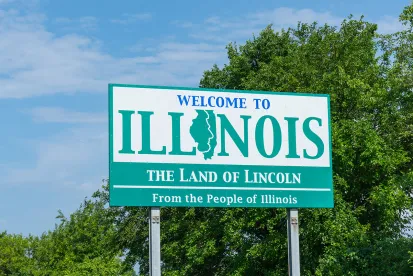On May 5, 2020, Illinois Governor J.B. Pritzker issued a phased, regional plan for reopening the State’s economy, entitled Restore Illinois: A Public Health Approach to Safely Reopen Our State (the “Plan”). The Plan is comprised of five phases, each of which permits different sectors of the economy to open or operate with increasingly regular functionality, while gradually easing restrictions on individual activity and the size of gatherings.
Movement from one phase of the Plan to the next (or, as the case may be, reverting back to a prior phase) will be based upon cumulative public health data, including new case growth, hospital surge capacity, and ability to test for and trace COVID-19 cases, and does not provide specific timetables or dates for each phase. While advancement from one phase to the next is the desired trend, the Plan also cautions that, “just as health metrics will tell us it is safe to move forward, health metrics may also tell us to return to a prior phase.”
The Plan divides the State into four geographic “health regions:” Northeast, North-Central, Central, and Southern. Each health region will be assessed independently in terms of movement between the Plan’s phases, based on cumulative health metrics from each region. Local health departments and regional healthcare councils will provide data to the Illinois Department of Public Health (IDPH), which will monitor all of the health data it receives and recommend to the Governor whether a health region can advance to the next phase or needs to revert to a prior phase. The full text of the plan, including a map of the four health regions, can be found here.
The Plan’s Five Phases
Phase One: Rapid Spread
-
Rapid spread of COVID-19, with hospital and ICU bed usage increasing. Only businesses identified or characterized as “Essential Businesses” in the then-effective Illinois Stay-at-Home Executive Orders as are permitted to operate.
Phase Two: Flattening1
-
Requirements for a health region to move to Phase Two: slowing of new case growth; hospital and ICU surge capacity remain available; testing available for all symptomatic health care workers and first responders in the health region; and statewide testing capacity must be at least 10,000 tests per day. While the Plan does not specify length-of-time requirements for these health metrics, this is likely because all health regions are currently in Phase Two. Should a health region revert back to Phase One, it is unclear how long it would need to meet these requirements in order to return to Phase Two.
-
During Phase Two: rate of infection slows and stabilizes. Hospitalization and ICU bed usage continue to increase, but are flattening as the rate of increase in bed occupancy declines. Revised stay-at-home guidelines allow for non-essential retail businesses to reopen for curbside pickup and delivery services.
Phase Three: Recovery
-
Requirements for a health region to move to Phase Three: less than 20 percent positivity rate for COVID-19 testing within the region; no greater than 10 percentage point increase in positive test rate over a 14-day period; no overall increase in COVID-19 hospital admissions for 28 consecutive days; sufficient ICU beds, medical and surgical beds, and ventilators available to accommodate a 14-percent surge in the usage of each; capacity to test all patients and all health care workers within the region (regardless of whether showing symptoms); and contact tracing available within 24 hours of diagnosis.
-
During Phase Three: rate of infections and hospitalizations continue to stabilize or decline. Employees of certain industries can return to their workplaces with social distancing and hygiene measures implemented by the employer. Retail stores can reopen with limited occupancy. Personal care businesses (e.g., hair salons) can reopen with implementation of social distancing measures and owner/employer-provided personal protective equipment (PPE) for employees and customers, as appropriate, while following any other IDPH-approved safety guidelines. Gatherings of 10 people or fewer permitted.
Phase Four: Revitalization
-
Requirements for a health region to move to Phase Four: all requirements for Phase Three relating to testing rates, stability of COVID-19-related hospital admissions, and hospital surge capacity must continue to be met throughout Phase Four. Additionally, widespread testing for all individuals in the health region must be available, and contact tracing must be available within 24 hours for over 90% of cases in the region.
-
During Phase Four: continued decline in the rate of infection. Hospitals have the capacity to handle a surge of new cases in their communities. Restaurants and entertainment venues can reopen with limited occupancy and strict public health procedures. These procedures have not yet been published, but may include providing PPE for employees and enforcing social distancing protocols. Schools can reopen with social distancing policies in place, and gatherings of 50 people or fewer are allowed.
Phase Five: Illinois Restored
-
Requirements for a health region to move to Phase Five: a vaccine becomes available or, alternatively, testing, tracing, and effective treatment are widely available throughout the State. Elimination of new cases over time through herd immunity or other factors may also permit advancement to Phase Five.
-
During Phase Five: All sectors of the economy reopen with new safety guidance and procedures set forth by IDPH. Conventions, festivals, and large events are permitted.
-
Given that the Plan’s Phase Five requirements are based on statewide health data and widespread availability of a vaccine or highly effective treatment, it is not likely that any region will move to Phase Five until all other regions meet applicable requirements.
What Does Each Phase Mean for Certain Businesses and Industries?
Retail:
-
Phase One: Only essential retail businesses may remain open, with tight restrictions.
-
Phase Two: Essential retail businesses remain open with restrictions. Non-essential stores may open only for delivery and/or curbside pickup.
-
Phase Three: All retail businesses may open with limited store occupancy and safety procedures set by the IDPH, including providing face coverings and/or PPE for employees and requiring customers to adhere to IDPH guidelines on face coverings and social distancing.
-
Phase Four: All retail stores remain open and continue to follow IDPH-approved occupancy limits and health guidelines.
-
Phase Five: Return to normal business operations, with new health and hygiene practices permanently in place.
Manufacturing:
-
Phase One: Only essential manufacturing permitted to continue.
-
Phase Two: Only essential manufacturing permitted to continue.
-
Phase Three: Non-essential manufacturing that can safely operate with social distancing permitted to reopen, following IDPH-approved safety guidance.
-
Phase Four: All manufacturing permitted to reopen, following IDPH-approved safety guidance.
-
Phase Five: Return to normal business operations, with new health and hygiene practices permanently in place.
Bars and restaurants:
-
Phase One: Open for delivery, pickup, and drive-thru only.
-
Phase Two: Open for delivery, pickup, and drive-thru only.
-
Phase Three: Open for delivery, pickup, and drive-thru only.
-
Phase Four: Premises may reopen while following occupancy limits and IDPH-approved safety guidance.
-
Phase Five: Return to normal business operations, with new health and hygiene practices permanently in place.
“Non-essential” businesses:
-
Phase One: Employees required to work from home, with the exception of employees necessary to maintain “Minimum Basic Operations” as defined in the effective Illinois Stay-at-Home Executive Order, found here.2
-
Phase Two: Employees required to work from home, with the exception of employees necessary to maintain “Minimum Basic Operations” as defined in the effective Illinois Stay-at-Home Executive Order.
-
Phase Three: Employees may return to the workplace while following IDPH-approved safety guidance. Employers are still strongly encouraged to facilitate remote work whenever possible, and to provide accommodations to COVID-19-vulnerable employees.
-
Phase Four: All employees return to workplaces under IDPH-approved guidelines.
-
Phase Five: Return to normal business operations, with new health and hygiene practices permanently in place.
Personal care services and health clubs:
-
Phase One: Businesses must remain closed.
-
Phase Two: Businesses must remain closed.
-
Phase Three: Barbershops and salons can reopen under IDPH-approved safety guidance. Health clubs may provide outdoor classes and one-on-one personal training.
-
Phase Four: All barbershops, salons, spas, and health clubs may remain open, with occupancy limits and IDPH-approved safety guidance.
-
Phase Five: Return to normal business operations, with new health and hygiene practices permanently in place.
Entertainment:
-
Phase One: Businesses must remain closed.
-
Phase Two: Businesses must remain closed.
-
Phase Three: Businesses must remain closed.
-
Phase Four: Cinemas and live entertainment venues may reopen, with occupancy limits and IDPH-approved safety guidance.
-
Phase Five: Return to normal business operations, with new health and hygiene practices permanently in place.
While the Plan contains the specific guidelines and health metrics outlined above, the Governor’s Office has characterized the Plan as an “initial framework” that will likely be updated as research and scientific developments progress. The State’s decisions regarding each health region’s status may reflect additional or different considerations as the pandemic moves forward.
As such, it is important to monitor announcements and orders from the Governor’s Office. While the health metrics detailed in the Plan are useful indicators of Illinois’ progress toward reopening, only these announcements and orders will concretely move health regions through the Plan’s five phases.
1 All four health regions were in Phase Two at the time of the Plan’s publication. As of the date of this memorandum’s publication, no health region has yet advanced to Phase Three.
2 Additional Executive Orders may be issued or modified after the date of this memorandum, which could differ from the content included here. Businesses should regularly monitor the status of all Executive Orders to ensure compliance with Orders then in effect.







 />i
/>i

